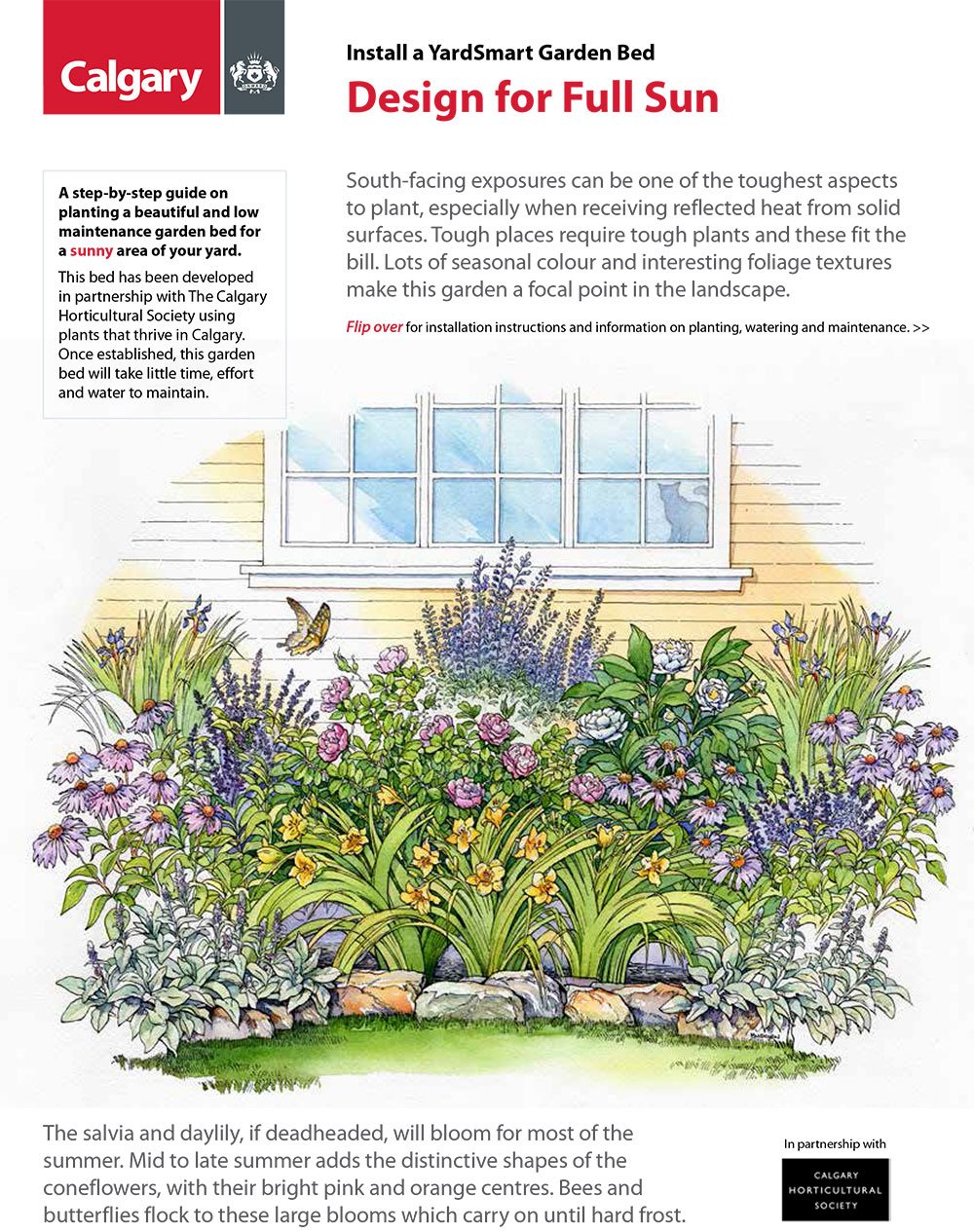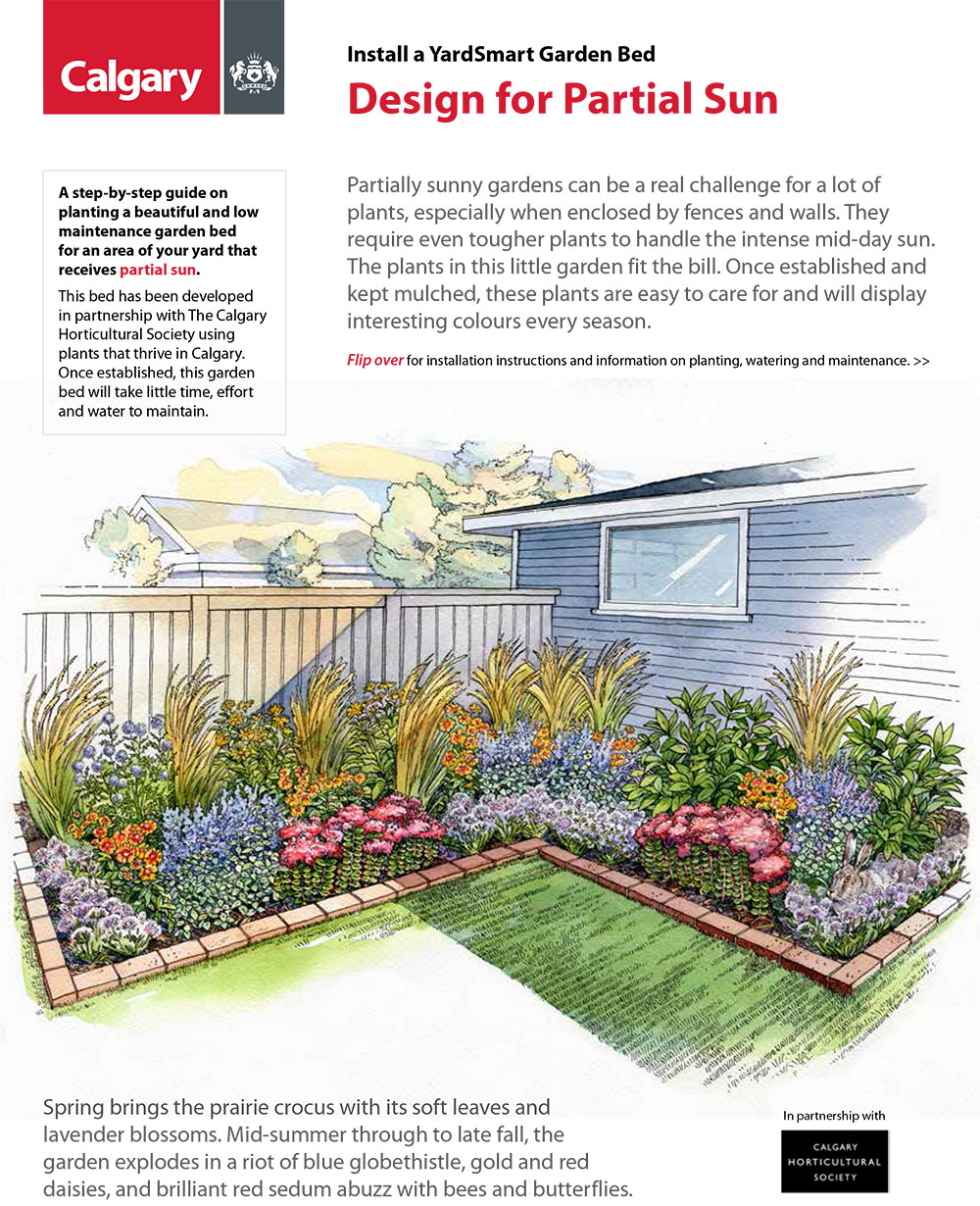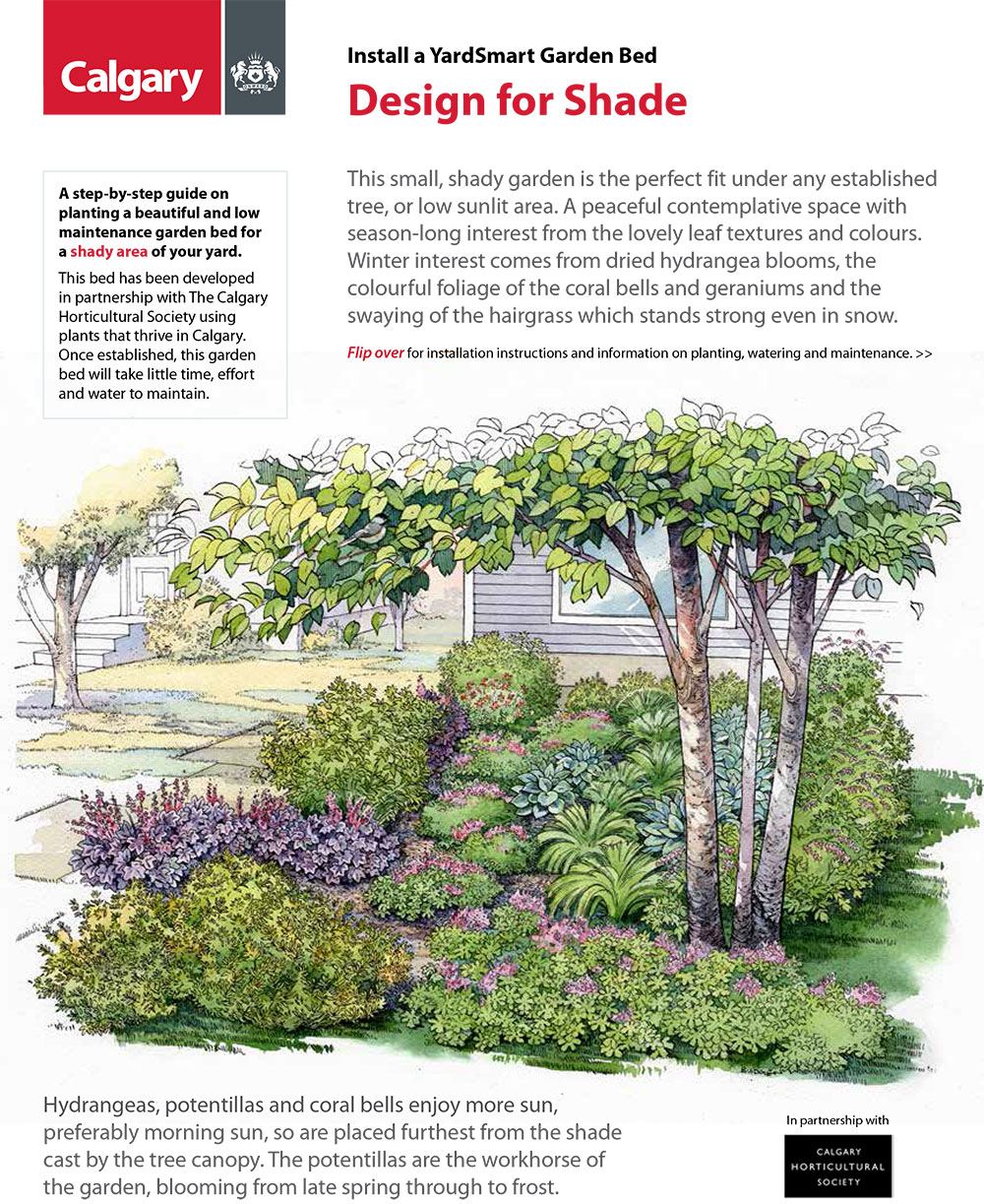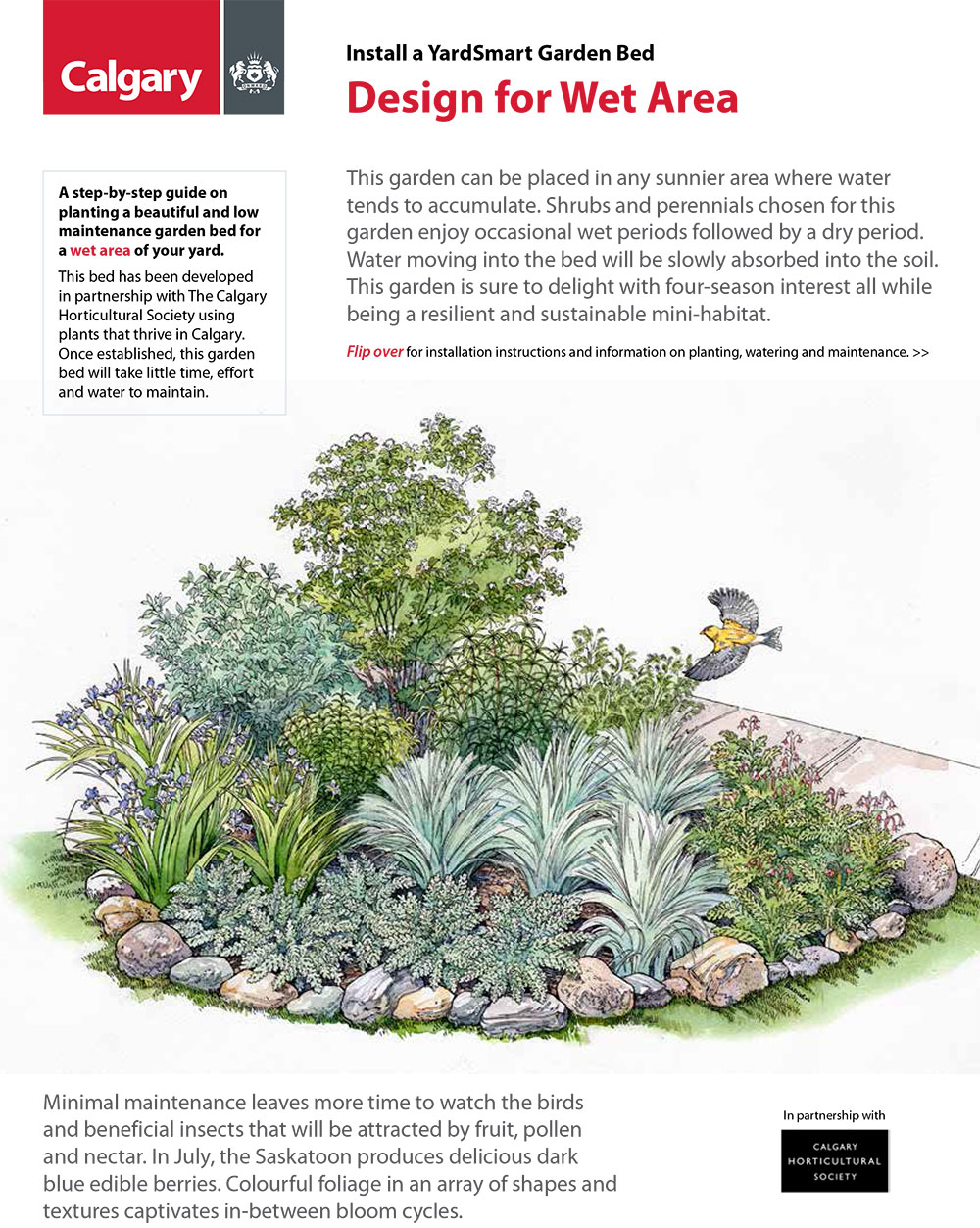How to care for your lawn
During spring and summer, your water use can jump by 30 to 40 per cent because of outdoor watering activities.
Save money on your water bills while still having a pristine lawn by following these lawn care tips. You can also check out our watering guides:
For information about watering during water restrictions, see Water Restrictions. For other resources on lawn and yard care, visit YardSmart.
Lawn care topics
Starting a yard from scratch
Starting your yard from scratch can seem like a daunting task. Taking the time to properly plan your yard will help you to create a tangible plan of action.
Find simple steps to set you up for gardening success, visit Planning Your Yard.
Limit your lawn
Lawns are great for relaxing and play, but they need a lot of water and work.
Consider replacing unused green space with YardSmart plants like annuals, perennials and groundcovers or trees and shrubs.
Need help designing your garden?
Not sure which plants to use or the right spot to plant them?
Download our step-by-step pdf guides or click on the image below to learn how to create beautiful and low maintenance garden beds which work in all areas of your yard:
Once established, these gardens take little time, effort, and water to maintain.
Mowing your lawn
Add these tips when mowing to keep your lawn healthy and reduce watering needs.
Keep your grass three inches long
A deeper root system will develop and more moisture is kept. Longer grass also keeps roots cool helping your lawn handle drought and severe heat
Leave grass clippings on your lawn
Grasscycling returns nutrients to the soil, discourages weeds and keeps moisture. Grass clippings are free fertilizer to help your lawn grow greener.
Timing is important
Don't mow your grass when it's wet or in the middle of the day when the sun is hot. Lawns cut short in the summer heat can get stressed out and become diseased.
Mow your lawn regularly
Avoid removing more than one-third of the grass length at each cut. This prevents cutting the crown of your grass blades. Frequent mowing keeps your grass healthy.
Keep your blades sharp
Make sure the blades on your lawnmower remain sharp. Cleaner cuts promote better grass health.
Mowing - Community Standards Bylaw
Under The City of Calgary's Community Standards Bylaw, private property owners must ensure that grasses do not exceed 15 cm (six inches) in height.
Maintaining a healthy, beautiful landscape is what being a good neighbour and part of a community is all about.
Aerating your lawn
Your lawn needs to breathe, and aeration can help. Aerating is the removal of small soil plugs or cores out of the lawn.
As lawns age, or sustain heavy use, your soil can be compacted. Grass roots require oxygen to grow and absorb nutrients and water, and compaction reduces the total amount of air in the soil.
If you are not sure you need aeration, take a core sample at least six inches deep. If grass roots extend only to the first one-two inches, your soil may be compacted.
Benefits of aerating your lawn
- Increasing the activity of soil microorganisms that decompose thatch
- Allows for deeper rooting of lawn to increase resiliency
- Improving rooting
- Help prevent fertilizer and pesticide runoff from overly compacted areas
Aeration is often followed by Overseeding or Fertilizing - spreading grass seed or fertilizer over the lawn, which falls into the holes.
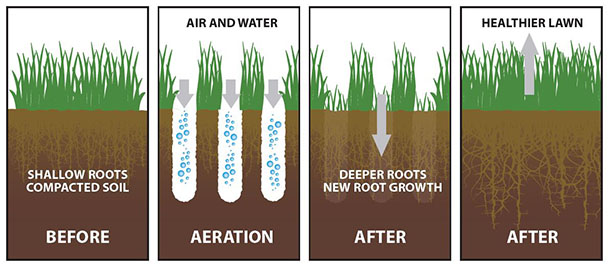
How to aerate your lawn
You can rent an aerator from many garden or rental centres, and some landscape companies will perform the service for you.
Be sure the machine has hollow tines or spoons to bring the soil core to the surface.
In Alberta, the best time to aerate is in May to June and again in mid-September. Soil cores are best left on the lawn so they can eventually work back in.
Tips when aerating
We don't recommend aerating soils that have stones, rocks or tree roots just below the surface. It is also hard to aerate heavy clay soils.
The soil should be moist but not wet. Water two days before aerating so the tines can get deeper into the soil and the soil cores come out easily.
Aerate in at least two directions to get good coverage. Be careful on slopes, near buildings, tree trunks and landscape beds.
Dormant vs. Dead Grass - How do I know?
When grass goes dormant for the winter, it shuts down and turns brown to save water and nutrients. Grass can also go dormant in the summer if your lawn is stressed from heat or lack of water.
Pick cool-season or drought tolerant grass species. These species will naturally go dormant during longer heat periods and will recover and become green again when the right temperature returns.
If you can pull your grass out easily, or the brown colour is not uniform on your lawn (for example: there are distinct patches of brown) then your grass may be dead.
Dethatching your lawn
Thatch is the layer of dead stems and roots that forms above the surface of the soil.Thatch can be good or bad for your lawn depending on how much is present.
A thin layer of thatch in lawn, half an inch or less, can provide insulation against temperature extremes and changing soil nature.
A thick thatch layer, one inch or more, can impact your lawn's ability to absorb nutrients. Wet thatch can hold excess water, preventing air from getting into the soil.
How to dethatch your lawn
The best time for dethatch is just as your lawn greens up. Don’t dethatch a young lawn or a lawn that is wet.
You can dethatch manually with a leaf rake, garden rake or thatching rake.
You can use a power dethatcher or a power rake. Both are performed with the same machine – the difference is the depth at which the cutting knives are set.
When power raking, the dethatching machine is set high so that the blades just skim the surface. To dethatch, the machine is set low so that the blades reach into the surface of the soil.
Using a power dethatcher
Power dethatchers can be rented or you can hire a landscape professional to do it for you. Note that they can be very heavy and will usually require more than one person to transport.
Before dethatching, mow your lawn to about half of its normal mowing height. If you have an in-ground irrigation system, be sure to mark the heads with a flag or stick so you can avoid damaging them.
Set the blade depth and spacing on your dethatcher. Typically the depth of blades are set to cut up to half an inch into the soil to remove the thatch and stir the surface of the soil. For spacing, tougher and cool season grasses typically require around one to two inches.
Make a few passes over the area you are dethatching with crossing patterns for better coverage. Once finished, be sure to remove all thatch and debris from your lawn. You can place this material in your Green Cart.
After your lawn is dethatched it is usually a great time to Fertilize or Reseed your lawn. If you reseed, follow-up by raking the seeds into the soil, add fertilizer and apply a light covering of organic matter such as compost.
It’s a good idea to give your lawn extra watering in the days after dethatching, especially during times of high heat and droughts.
What is thatch?
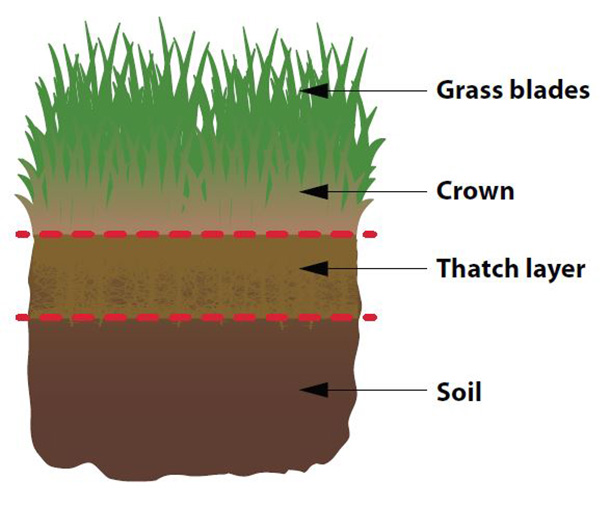
Fertilizing your lawn
Fertilizing your lawn provides nutrients that aid healthy growth. Established lawns usually don’t need fertilizing but if you’re going to fertilize, follow these tips.
Types of fertilizer
Choose a slow-release type. Quality slow-release fertilizers give balanced nutrition over time to develop a healthier plant and root system that combats heat, cold, drought and other stresses.
Organic lawn fertilizer, like compost, also provides vitamins and minerals that your lawn uses to stay lush and green. This fertilizer might include animal proteins derived from processed animal products or waste, potash, seaweed, manure, compost and corn gluten meal.
Organic lawn fertilizer applied two to three times per year can take the place of many artificial treatments depending on the needs of your lawn.
When to fertilize
Early summer (after your lawn begins to actively grow) and fall are the best times to fertilize. Fall fertilization helps winter hardiness of the grass and provides nutrients, especially potassium, which makes turf stronger.
The time of day you fertilize depends on weather conditions. Fertilizer should not be applied if rain is forecast within the next 24 hours.
Be careful not to overwater your lawn after fertilizing – this can cause nutrients to leach off your lawn and down the storm drain, and eventually into our rivers.
How to fertilize
Apply about a quarter pound of nitrogen when fertilizing with a cart or hand spreader. It also helps to provide a small amount of nitrogen during the year; grasscycling (leaving grass clippings on the lawn) is the perfect way to do this.
The percent of nitrogen is always the first number on the fertilizer bag. For example, a 34-6-6 fertilizer contains 34 per cent nitrogen per bag weight. We recommend a 23-3-3 ratio of nitrogen-phosphorus-potassium for a slow-release fertilizer.
Healthy Soil = Healthy Lawn
Your lawn is only as healthy as the soil beneath it. Soil testing measures the available plant nutrients in soil, how acidic soil is, and its organic matter content.
You should test your soil because fertilizer and lime recommendations can be made for your lawn based on that data. Soil testing is two steps:
- Collect a soil sample from your lawn
- Send it to a laboratory for analysis
Since front and back yards are often treated differently, you should take separate samples from each area. Do not mix soil from lawns with soil from vegetable and flower gardens.
Calgary soils tend to be more clay-based and alkaline. They can be mixed with compost to improve quality. See our free Green Cart compost pickup dates.
Seeding or sodding your lawn
Overseeding may be needed to increase the density of your lawn. A dense lawn has fewer weeds and is healthier.
Pests, extreme weather conditions and neglect can also damage lawns, even when the soil is in good condition.
If your lawn is a little thin, proper mowing, fertilizing and watering may be all it needs. If that doesn’t help, overseeding with a quality lawn seed may be the answer.
Choosing your seed
Choose a grass seed high in Fescue content (at least 60 per cent) and low in Kentucky Blue content (20 per cent at the most), remembering to use cool season varieties.
Select a seed mixture that is high in physical seed attributes, such as purity and germination, and also contains the best composition of grass for the use intended.
Soil fertility, moisture availability, sunlight levels and traffic affect the tyope of blend that will provide the best results for your yard.
Look to sow your lawn with a blend of grass seed varieties. Check our local nurseries and garden centres in Calgary for drought tolerant blends of lawn seed.
Adding seed to your lawn
Before you spread the seed over the thin areas, make sure there will be good soil-to-seed contact, and rake away any dead grass or debris.
Dethatchers, aerators or vertical mowers can also be used to prepare the lawn prior to overseeding.
Time your overseeding with a day before rain. Don’t do before a hot weather forecast. The seed will need water to germinate.
Apply 900 grams (2 pounds) per 1,000 square feet or more if the lawn is thin (up to 1.8 kilograms or three to four pounds).
Using sod for your lawn
Sodding your lawn can be a quicker alternative to starting a lawn from seed. It is important to choose the grass seed mixture carefully and according to the care and use your lawn will receive.
Look for native, drought-tolerant sod, such as a sod high in fescues. These require less irrigation and maintenance, will thrive under varying soil conditions and will be heartier to our climate.
Kentucky Bluegrass mixtures, while hearty to disease and quick to green, require much more irrigation and maintenance than native, drought tolerant sod species.
Get your lawn ready for winter
Actions that you take in the fall will set you up to have a healthy lawn in the spring.
Starting at the end of August, leave your grass longer. This will help your grass tolerate winter better.
Let your grass grow into dormancy. Stop watering your lawn once the day begins to shorten and nights begin to cool off.
Before the temperature drops, drain your hoses, empty your rain barrel and store them away to prevent cracking and freezing.


